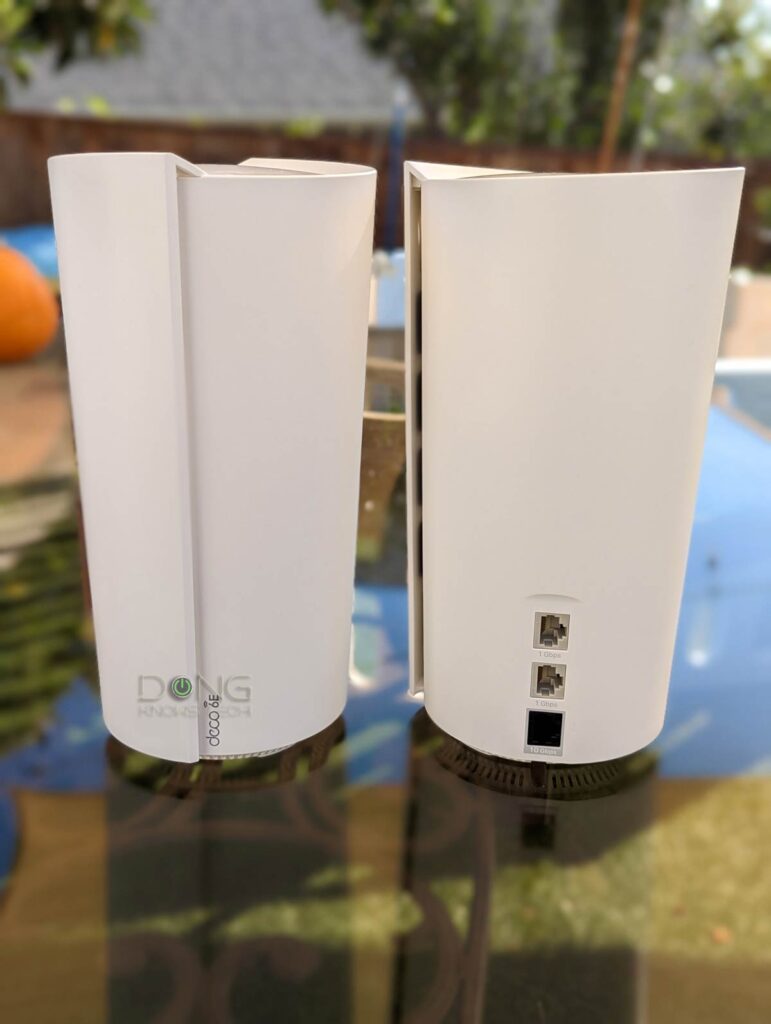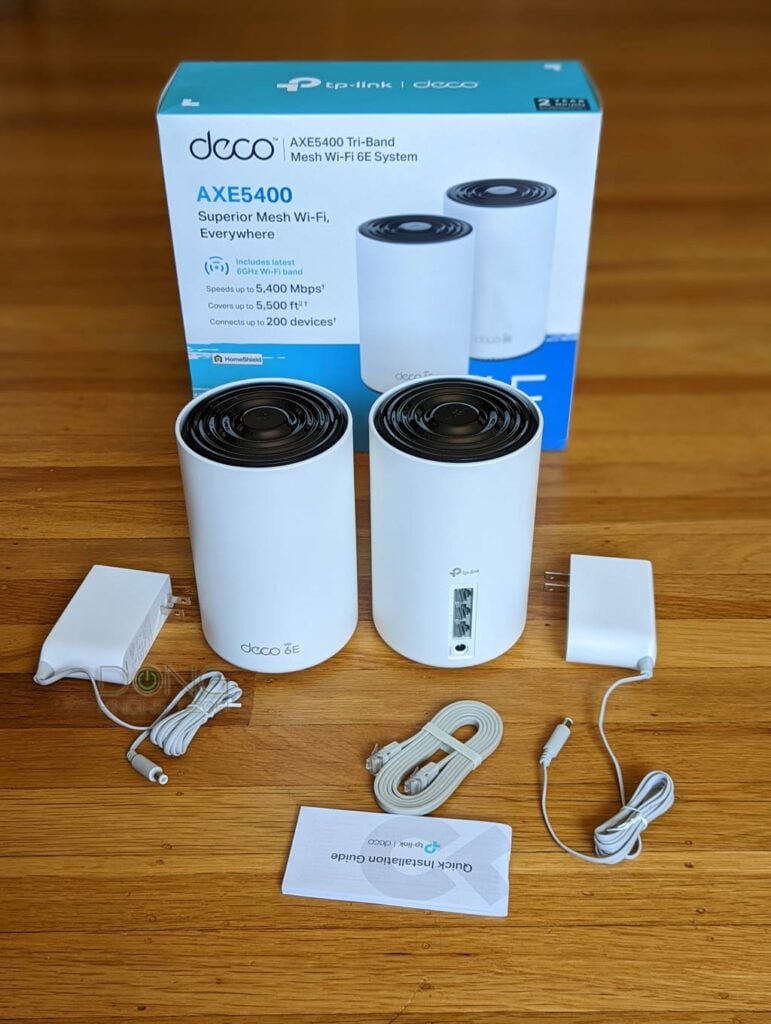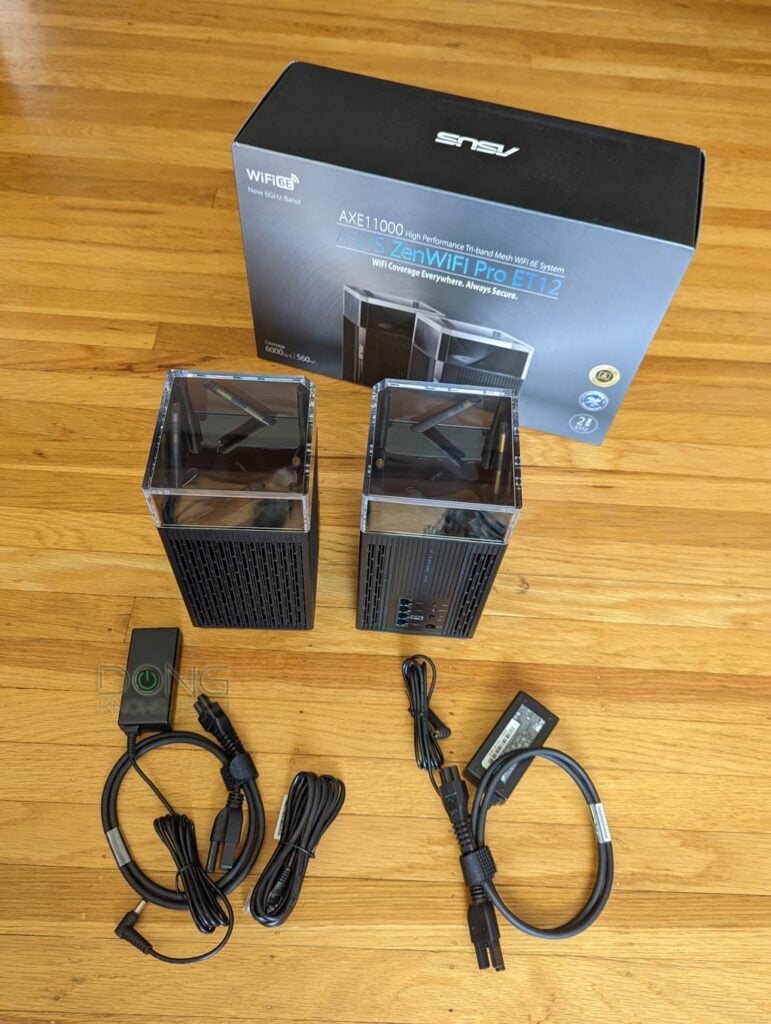This list includes the best Wi-Fi 6E mesh systems and is sorted in the review order. The numbers are just numerical and not meant to be the ranking.
Dong’s note: This list was originally part of this piece on Wi-Fi 6E routers, and I moved it out on October 30, 2022, to clarify the subject.
Wi-Fi 6E Mesh Systems: A couple of important notes
Wi-Fi 6E is the extension of Wi-Fi 6, which has an additional 6GHz band.
That said, Wi-Fi 6E has the same feature and speed grades as Wi-Fi 6. The only difference is the 6GHz band is clean and, therefore, can archive the top speed more easily and reliably.
In return, the 6GHz band has a noticeably shorter range than the 5GHz and 2.4GHz bands. And that makes things tricky for Wi-Fi 6E mesh systems — no band can work reliably as the backhaul.
The point is this: If you’re looking for a Wi-Fi 6E mesh, it’s best to use it via wired backhauling — using network cables to link the hardware. And if you want the best possible performance, Multi-Gig backhauling is the way to go.
With that, let’s check out your current best options.
6. TP-Link Deco XE200: A solid mesh that’s also a missed opportunity
(If you didn’t read the intro, this is the latest member on this list — the number is only numerical, not the ranking.)

The Deco XE200 is a significant upgrade to the XE75 below. Unfortunately, having just one Multi-Gig port, it fails to be the ultimate mesh — there’s no chance for us to get a Multi-Gig wired backhauling setup out of it.
Still, for those with Gigabit or slower broadband, the XE200 is an excellent buy.
Pros
10Gbps port, 6GHz support, top-tier Wi-Fi, reliable Wi-Fi performance with extensive coverage
Easy to use; comparatively affordable
Cons
Single Multi-Gig port, spartan Wi-Fi, and network customization
Fluctuating Wi-Fi speeds, Mobile app, and login account required; HomeShield Pro costs money
No USB port, impractical design
5. TP-Link Deco XE75: The most affordable Wi-Fi 6E mesh to date

The 2-pack Deco XE75 — also available as the 3-pack XE5300 variant — is the first Wi-Fi 6E solution from TP-Link.
Featuring 2×2 Wi-Fi specs and having no Multi-Gig port, the new mesh is disappointing. That’s until you learn about this cost.
At just $300 for a 2-pack, it’s the most affordable among Wi-Fi 6E hardware. And for that price point, it’ll make an excellent buy for sub-Gigabit networking needs — especially when used with a wired backhaul.
Pros
Wi-Fi 6E-ready with reliable and extensive coverage
Cons
No Multi-Gig port, Link Aggregation, or Dual-WAN
TP-Link login account and mobile app required
No real, local web-based management
Only three network ports on each unit
4. Asus ZenWiFi Pro ET12: First Multi-Gig wired mesh set out of the box

The ZenWiFi Pro ET12 is the second Wi-Fi 6E mesh system from Asus.
Like the ET8 that came out almost half a year ago, this new mesh doesn’t have an additional band to work as backhaul.
As a result, it works best in a wired backhaul setup. And in this case, thanks to the top-tier Wi-Fi specs and the two Multi-Gig ports, it might be one of the best mesh Wi-Fi systems with Multi-Gig wired backhaul you can get.
Pros
Wi-Fi 6E-ready, extensive Wi-Fi coverage with top performance in specific setups with possible fas Wi-Fi performance in certain setups
Dual Multi-Gig pots with Multi-Gig wired backhaul, flexible port configurations
Excellent performance and coverage as a standalone router
Tons of useful features and settings, flexible Wi-Fi customization
AiMesh 2.0 full support, helpful mobile app, no login account required
Cons
Bulky, no USB, only four network ports
Fluctuating performance as a fully wireless mesh due to the lack of a dedicated backhaul band
Expensive, not wall-mountable
3. Netgear Orbi RBKE960 Series: The symbol of success (very expensive, that is)

Available as a 3-pack — RBKE963 (white) or RBKE963B (black) — the new Orbi Wi-Fi 6E system is insanely expensive costing $1500 — and you have the option to pay even more over add-on subscriptions.
On top of that, it has fewer included features and settings compared with previous Orbi sets.
In return, you’ll get substantial and powerful hardware. The most exciting part is it can do Multi-Gig wired backhaul, though you’d need a switch if you want to use both satellite units that way.
Pros
Powerful hardware with Quad-band Wi-Fi and Multi-Gig wired backhaul support
Excellent Wi-Fi coverage, fast performance
More Wi-Fi networks than previous Orbis, including two additional virtual SSIDs
Cons
No web-based Remote Management, few free features; mobile app (with a login account and even subscriptions) is required to be useful
Rigid Multi-Gig ports’ roles, few Multi-Gig ports
The 2nd 5GHz band is unavailable to clients even with wired backhauls, no 160MHz channel width on 5GHz
Limited Wi-Fi customization, bulky design
2. Asus ZenWiFi ET8: Excellent for a wired home

The ZenWiFi ET8 is Asus’s Wi-Fi 6E alternative to the ZenWiFi XT8, a same-design purpose-built Wi-Fi 6 mesh system for a fully wireless setup.
In that sense, the ET8 is not an upgrade to the older cousin — it’s terrible in a wireless configuration. Instead, it’s an alternative for an airy home or one already wired with network cables.
The ZenWiFi ET8, for now, is available as a 2-pack, but you can use each hardware unit as a standalone router for a small home. And it works very well in that case.
Pros
Reliable and extensive coverage with possible fast Wi-Fi performance in certain setups
Wi-Fi 6E ready, Multi-Gig WAN, and Dual-WAN support
Excellent as a standalone router
Tons of useful features and settings, flexible Wi-Fi customization
Cons
Comparatively slow performance in most use cases
No Link Aggregation or Multi-Gig LAN port
Only four network ports on each hardware unit
1. Linksys AXE8400 Atlas Max 6E: First Wi-Fi 6E mesh system
(If you didn’t read the intro, this is the oldest member on this list — the number is only numerical, not the ranking.)

Linksys seemed determined to lead the charge in Wi-Fi 6E. Apart from the MR7500 below, this AXE8400 Atlas Max 6E is the company’s 2nd 6E broadcaster and the first mesh system of the new Wi-Fi standard.
The new mesh consists of three identical tri-band 6E broadcasters, model MX8500. Each can work as a standalone router, but you can combine them into a system to deliver coverage of all three bands (2.4GHz, 5GHz, and 6GHz) in a large property.
That’s if you think you have enough reasons right now to invest $1200 in it. Hint: It’s not worth it. Make sure you have wired your home and wait until the price drops.
Pros
Reliable performance, extensive coverage
Excellent NAS performance when hosting external storage device(s)
Separate SSID for each band
Cons
Comparatively slow mesWi-FiFi speeds in homes with walls
Limited Wi-Fi settings and features, mobile app coercion
No Multi-Gig LAN port (main router), Dual-WAN, or Link Aggregation
No setting backup and restore
Best Wi-Fi 6E mesh systems of 2022: The performance chart and the takeaway
Below are the performance charts of the systems listed above, tested in all possible ways, and sorted using alphabetical order for easy viewing.


When possible each band is tested separately and the satellites are tested via all possible backhauls.


<6GHzBH>: The 6GHz band is used as the backhaulul
<WBH>: Wired backhaul — the fastest available link is used (1Gbps, 2.5Gbps, 5Gbps or 10Gbps.)
No matter which system you pick, if it has no Multi-Gig WAN port, the broadband speed will be limited to 1Gbps. And if there’s no Multi-Gig LAN port, the entire system is generally limited at Gigabit, too.
If you have no network cables, it’s best to get a system that has an additional 5GHz band that works as the dedicated backhaul.






More Stories
iZigg Mobile Review – Does iZigg Mobile Marketing (90210) Really Work?
Internet Fax Services – Do’s and Don’ts
An Introduction To IPTV